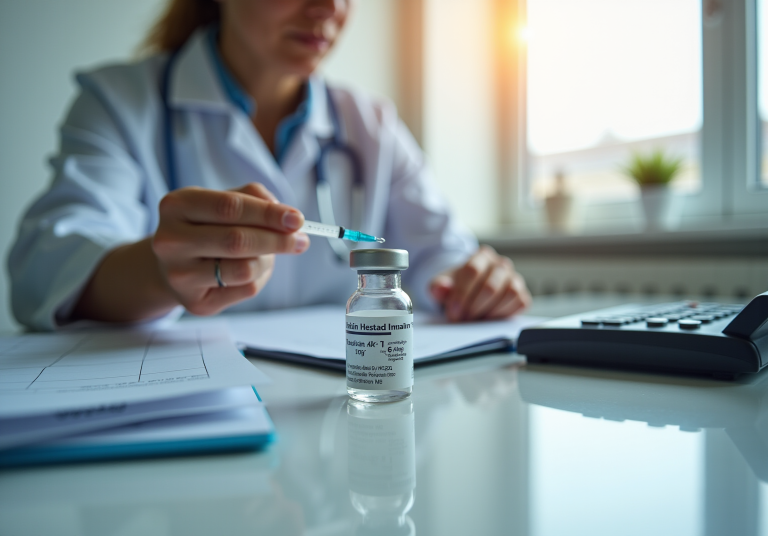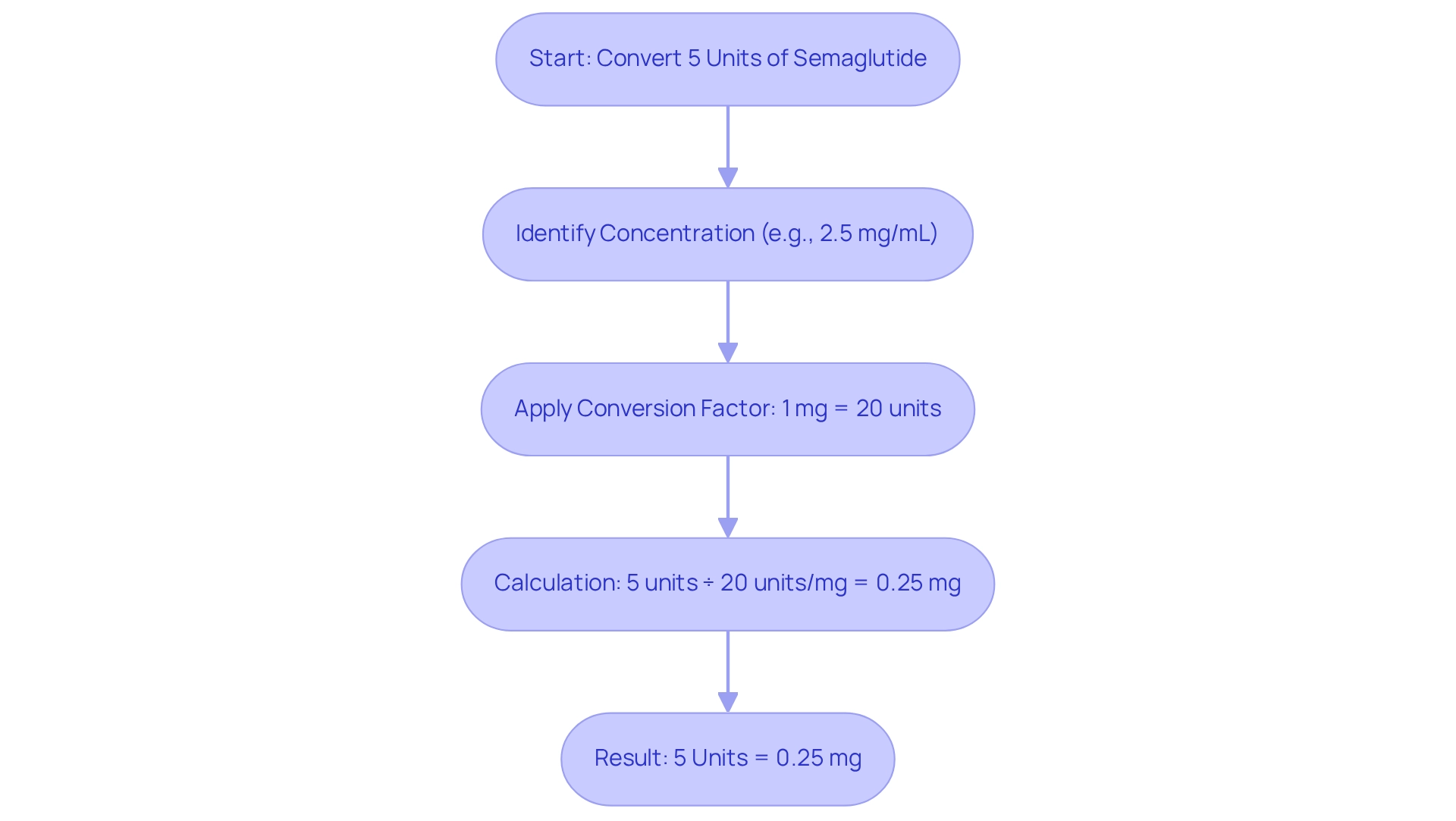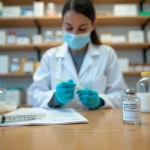Overview
Understanding the conversion of semaglutide can feel overwhelming, but we’re here to help you navigate it.
Five units of semaglutide equate to 0.25 mg, as one mg corresponds to approximately 20 units of this important medication.
This calculation highlights the significance of knowing the concentration of the solution, which is crucial for ensuring accurate dosing.
By grasping this information, you can feel more confident in your treatment journey and take meaningful steps toward your health goals.
Introduction
In the evolving landscape of diabetes management and weight loss, semaglutide emerges as a truly revolutionary treatment option. As a glucagon-like peptide-1 (GLP-1) receptor agonist, it brings remarkable benefits, from significant weight reduction to improved cardiovascular health. Yet, we understand that the effective use of semaglutide depends on a clear grasp of dosage measurements and conversions, especially since it is administered in units rather than milligrams.
Navigating the complexities of semaglutide can feel daunting, particularly with potential challenges in dosage accuracy and the critical importance of precise calculations. But remember, you are not alone in this journey. This article delves into the essentials of semaglutide dosing, offering valuable insights on:
- Conversion methods
- Common pitfalls to avoid
- Tools that can help you achieve optimal therapeutic outcomes
Together, we can navigate this path towards better health and well-being.
Understand Semaglutide and Its Measurement Units
Semaglutide is a glucagon-like peptide-1 (GLP-1) receptor agonist that offers hope for those managing their weight and tackling type 2 diabetes. Administered primarily through injection, it is crucial to understand how many mg is 5 units of semaglutide for accurate dosing. For example, 1 mg of the medication is approximately equivalent to 20 units, leading to the inquiry of how many mg is 5 units of semaglutide, though this can vary depending on the solution’s concentration. Familiarizing yourself with these measurements is essential to ensure you receive the correct dosage as prescribed by your healthcare provider.
Recent studies shed light on the remarkable efficacy of this medication in clinical settings. Patients using semaglutide have experienced significant weight reduction, losing about twice as much compared to those on traditional anti-obesity treatments like orlistat. Additionally, data indicates that individuals on this medication saw a 15% lower occurrence of diabetic retinopathy compared to those solely using insulin, showcasing its dual benefits in weight management and diabetes treatment. As noted by Omar Khaled in the SELECT trial, patients taking Ozempic had a 20% lower risk of major adverse cardiovascular events (MACE) than those on placebo, underlining the cardiovascular advantages of this medication.
Real-world examples of semaglutide administration highlight its practical application. In clinical practice, healthcare professionals stress the importance of precise dosage measurement to optimize therapeutic outcomes. A thorough evaluation titled “Safety Profile of Semaglutide” examined the safety and adverse effects associated with its use. The evaluation found that the medication has a favorable safety record, with most adverse events being mild to moderate, reinforcing its viability as a long-term weight management solution.
As the use of GLP-1 receptor agonists continues to rise, they are transforming the landscape of metabolic disease treatment and inspiring new approaches to weight management. Understanding these measurements and their implications is vital for anyone considering this medication as part of their health journey. Remember, we’re here for you, and together, we can achieve your goals.
Convert 5 Units of Semaglutide to Milligrams
We’re here to guide you through the straightforward process of converting 5 units of semaglutide and determining how many mg is 5 units of semaglutide. First, identify the concentration of your solution. For instance, if your solution has a concentration of 2.5 mg/mL, this indicates that each milliliter contains 2.5 mg of the active ingredient.
Next, apply the conversion factor. Since 1 mg is approximately equivalent to 20 units, you can find the milligrams for 5 units by performing the following calculation:
5 units ÷ 20 units/mg = 0.25 mg.
This means that the question of how many mg is 5 units of semaglutide corresponds to 0.25 mg. Remember, it’s crucial to double-check your calculations and consult with your healthcare provider if you have any uncertainties regarding your dosage.
Understanding the conversion formula and the factors influencing it is essential for achieving effective treatment outcomes with Wegovy®, an FDA-approved medication for weight management. Accurate administration and continuous observation are vital in using the medication effectively, ensuring that you can optimize your health advantages. Moreover, this medication has demonstrated the ability to lower the likelihood of significant cardiovascular incidents, such as heart attacks and strokes, especially in adults with type 2 diabetes and pre-existing cardiovascular conditions. This underscores the importance of accurate dosing. Always consult with your healthcare provider to ensure you are on the right path. Together, we can achieve your goals and enhance your well-being.
Address Common Challenges in Dosage Conversion
When converting dosages of semaglutide, it’s important to recognize that several common challenges may arise. Understanding these can help you feel more confident in your treatment journey.
- Misunderstanding Concentration: Different brands or formulations may have varying concentrations. Always check the label to confirm the concentration of your semaglutide solution. This is a crucial step to ensure you’re using the right amount.
- Calculation Errors: Simple arithmetic mistakes can lead to inaccurate dosages. To avoid this, consider using a calculator or a medication conversion chart to double-check your calculations. Remember, it’s okay to seek help if you’re unsure.
- Syringe Measurement: Ensure you are using the correct syringe type, whether it’s an insulin syringe or a TB syringe, as they may have different unit markings. This small detail can make a significant difference in your dosing accuracy.
- Consultation: If you ever feel uncertain about your medication amount, don’t hesitate to consult your healthcare provider for clarification. They can provide guidance tailored to your specific treatment plan, ensuring you feel supported every step of the way.
- Documentation: Keeping a record of your dosages and any changes made to your treatment plan is vital. This practice helps you track your progress and ensures consistency, which is key in your weight loss journey.
Addressing these challenges is critical. Studies indicate that up to 30% of injuries caused by prescriptions in hospitals stem from medication errors. Moreover, it is estimated that up to 80% of medication error harm could be averted. Implementing strategies such as computer-assisted prescribing software, as noted by Desalegn Feyissa, can significantly reduce these risks, enhancing the accuracy of medication administration.
By being proactive and knowledgeable, you can reduce the chances of mistakes in medication administration. Together, we can achieve your goals. Additionally, recommendations from case studies emphasize the importance of improved communication among healthcare providers to further mitigate these challenges. Remember, you’re not alone in this journey, and we’re here for you.
Utilize Tools and Resources for Accurate Dosing
To ensure precise dosing of semaglutide, it’s important to consider leveraging tools and resources that can support you on this journey:
- Dosage Conversion Charts: These charts are quick references for converting units to milligrams and vice versa. Easily accessible online or from your healthcare provider, they are essential for precise measurement.
- Mobile Apps: A variety of mobile applications are designed specifically for medication management. With dose calculators, these apps help track amounts and send reminders for medication schedules. In 2025, the most popular apps in this category are user-friendly options that cater to your needs for health tech solutions.
- Syringe Guides: Many pharmacies offer guides that explain how to read syringe measurements accurately. Familiarizing yourself with these guides is vital to avoid miscalculations and ensure accurate measurement.
- Consultation with Healthcare Providers: Regular consultations with your healthcare provider are crucial for addressing any uncertainties regarding your dosage. These check-ins help ensure that you stay on track with your treatment plan and receive personalized guidance tailored to your health needs.
By utilizing these resources, you can enhance your understanding of semaglutide dosing, especially how many mg is 5 units of semaglutide, and support your weight loss journey effectively. Remember, together, we can achieve your goals, and you are not alone in this process.
Conclusion
Navigating the complexities of semaglutide dosing is essential for achieving optimal health outcomes, especially in weight management and diabetes care. We understand that the measurement units and conversion factors can be overwhelming, but knowing that 1 mg of semaglutide is approximately 20 units can help you feel more confident in your treatment. Accurate dosage conversion is a fundamental step in ensuring safe and effective use, and we’re here to support you through this process.
Common challenges, such as:
- Misunderstanding concentrations
- Making calculation errors
- Using incorrect syringes
can lead to significant dosing mistakes. By addressing these issues proactively and utilizing available tools—like dosage conversion charts, mobile apps, and syringe guides—you can minimize the risk of errors and enhance your treatment experience. Regular consultations with healthcare providers also play a vital role in maintaining accurate dosing and adapting treatment plans as needed.
Ultimately, embracing the knowledge and resources available for semaglutide dosing empowers you on your journey toward better health. As the landscape of diabetes management and weight loss continues to evolve, staying informed and vigilant in dosage accuracy can lead to improved therapeutic outcomes and a healthier, more fulfilling life. Together, we can achieve your goals and support you every step of the way.
Frequently Asked Questions
What is semaglutide and what is its primary use?
Semaglutide is a glucagon-like peptide-1 (GLP-1) receptor agonist primarily used for managing weight and treating type 2 diabetes.
How is semaglutide administered?
Semaglutide is primarily administered through injection.
How many milligrams are in 5 units of semaglutide?
5 units of semaglutide is approximately equivalent to 0.25 mg, as 1 mg of the medication is roughly equivalent to 20 units.
What are the benefits of using semaglutide compared to traditional anti-obesity treatments?
Patients using semaglutide have experienced significant weight reduction, losing about twice as much compared to those on traditional treatments like orlistat.
How does semaglutide affect the occurrence of diabetic retinopathy?
Individuals using semaglutide have shown a 15% lower occurrence of diabetic retinopathy compared to those solely using insulin.
What cardiovascular benefits are associated with semaglutide?
Patients taking semaglutide, specifically Ozempic, have a 20% lower risk of major adverse cardiovascular events (MACE) compared to those on placebo.
What is the safety profile of semaglutide?
Semaglutide has a favorable safety record, with most adverse events being mild to moderate, making it a viable long-term weight management solution.
Why is it important to understand the measurement units of semaglutide?
Understanding the measurement units is crucial for accurate dosing to ensure patients receive the correct dosage as prescribed by their healthcare provider.


















